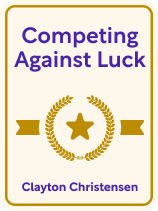

This article is an excerpt from the Shortform book guide to "Competing Against Luck" by Clayton Christensen. Shortform has the world's best summaries and analyses of books you should be reading.
Like this article? Sign up for a free trial here.
What is a customer-focused strategy in business? How can you use it to generate more business growth and success?
Clayton Christensen argues that, in today’s competitive landscape, achieving business success requires more than just offering a good product or service. He claims that a customer-focused strategy is what it takes to win over customers in the long term and truly satisfy their expectations.
Read on to learn Christensen’s explanation of a customer-focused strategy in business.
The Basics of a Customer-Focused Strategy
In Competing Against Luck, Clayton Christensen offers a conceptual framework for analyzing consumer demand and guiding product innovation. He explains that every time consumers make a purchase, they’re trying to accomplish one specific task. Knowing this, you can design and sell a product that can’t possibly fail because it fits that task perfectly. He further explains how to build an effective organization by centering all its operations around the idea of the consumer task. Here, we’ll discuss three customer-focused strategies organizations can use to thrive, according to Christensen.
#1: Use Repeatable Procedures
In terms of a customer-focused strategy, Christensen argues that the end goal of all organizations should be to accomplish a specific customer task as well as possible. Christensen defines a task as a specific purpose that customers accomplish by buying a product, such as “entertain me and help me forget about work during my vacation.” A customer-focused strategy in business includes designing an effective product and doing everything necessary to ensure that it satisfies the customers who buy it, claims Christensen.
To that end, Christensen recommends identifying a series of procedures that, when completed, always result in a product that gets the customer’s task done satisfactorily. Then, repeat these procedures. Consistent procedures mean that even if individual members of your organization come and go, the result stays the same, guaranteeing customer satisfaction.
For example, if you’re selling a video game that solves the task “give me a thrilling, immersive second life I can escape to,” you must establish a procedure for how you’ll resolve bugs that could ruin the immersive experience. This procedure might be: First, identify and record the bug; then, create a solution and run it on test servers; and finally, upload it to the game and publish an announcement to the players. Following these instructions ensures that the team achieves consistent results every time.
Christensen offers two tips for using repeatable procedures to increase your company’s chances of success:
Use Repeatable Procedures to Determine Organizational Structure
Rather than defaulting to what you assume an organization like yours should look like, define the procedures necessary to accomplish a consumer task and create a corporate structure to match them, argues Christensen. This is necessary because if your organizational structure doesn’t match your task-focused procedures, you may end up with workers whose procedures are all productive in theory, but in reality work against each other.
For example, if you’re trying to sell fashionable winter coats, you might have a full research and development team trying to create warmer coats as well as a design team trying to create slimmer and more flattering coats. If you keep these teams separate, they might work against each other—the development team creating unflattering coats and the design team trying to strip away the parts making it warm. Instead, ensure no efforts are wasted by combining these two teams into a single design team attempting to resolve the consumer task of a warm coat that looks good.
Acknowledge That Repeatable Procedures Can Change Over Time
Although the strength of organizational procedures is that they provide consistent results when you repeat them, Christensen notes that sometimes, you’ll have to change these procedures over time, adapting to changing circumstances. Tying procedures to the consumer task makes this possible: Even if you completely overhaul your company’s procedures, if the new procedures still match the consumer task, you haven’t compromised the organization’s success.
For example, a movie theater focused with the customer-focused strategy of “entertain groups of friends and family when they’re looking to do something out of the house” might adapt to the rise of on-demand streaming by updating their procedures to give viewers a theater experience they can’t get at home. The theater could hire an event coordinator to throw unique social movie nights. Since these new events are directly serving the consumer task, they’ll help your business succeed.
#2: Assess Your Procedures With the Right Data
According to Christensen, tracking the right data is essential for ensuring that your organization consistently satisfies its customer-focused strategy. Although the wrong data can easily lead you astray (as we discussed earlier), metrics that are directly tied to a consumer task are necessary to assess whether your organization is successfully executing its procedures.
Helpful task-centric metrics are typically external rather than internal—that is, they directly reflect the results you deliver to the customer, rather than employee efforts. External metrics directly represent how well you’re satisfying the consumer task, while internal metrics are distanced from the consumer task and may paint a misleading picture of how well you operate.
For instance, imagine you’re a wedding caterer solving the consumer task of “make our wedding run smoothly by serving great food.” Rather than tracking internal metrics like how quickly you can cook the food or the percentage of full plates you can compose in half an hour, track external metrics like what percentage of wedding guests you serve within half an hour or what percentage of the food you serve is still warm.
| Avoid All Vanity Metrics Ineffective metrics are called “vanity metrics” because tracking them makes your organization look good upon review. However, in reality, these metrics have no connection to how effective your procedures are. In other words, they only fuel your vanity. Internal metrics that track employee efforts rather than customer results are one type of vanity metric (as Christensen notes). For instance, a wedding caterer could boast the internal metric of “we finish cooking dinner within 30 minutes 100% of the time,” but if that food doesn’t get delivered on time due to careless waitstaff, it’s just a vanity metric masking the organization’s failure. Christensen states that external, task-centered metrics are effective, but in The Lean Startup, Eric Ries argues that external metrics are sometimes vanity metrics, too. External metrics that reflect your total customer results over all time—for instance, the total number of weddings you’ve catered—are vanity metrics because they’ll increase over time no matter how effective your procedures are. In contrast, external metrics that compare customer results across different spans of time are effective for a customer-focused strategy because they’ll only increase if your procedures are getting better. For example, the number of weddings that your company caters to in a given week is a valid metric for assessing the effectiveness of your marketing. |
#3: Use the Consumer Task to Guide All Employees
Once you’ve identified the consumer task your organization is trying to resolve, Christensen contends that you can use that task as the rationale for every decision anyone in your organization makes. As long as a worker knows the task they’re trying to resolve, they’ll be able to weigh the pros and cons of any decision and act productively in complex situations. Rather than worrying about what they’re “supposed” to be doing, they can see for themselves what decisions would best satisfy the consumer and act accordingly. This allows managers to be more hands-off in directing their subordinates.
In contrast to a customer-focused strategy, other companies try to empower and inspire their workers with mission statements that are too vague for them to realistically use while making decisions on the job.
For instance, imagine you own a restaurant. If a group of diners is being too loud, workers following a vague mission statement of “the customer is always right” might ignore them. If workers were instead told to prioritize the consumer task of “help me relax on a night out,” they would confront the disruptive customers. They’d recognize that the disruption is preventing them from solving this task for all the other patrons.
(Shortform note: In The Dichotomy of Leadership, Jocko Willink and Leif Babin also argue that leaders should identify the organization’s specific unifying purpose (the consumer task, in a business context) and publicize it so every team member can use it to guide their decisions. However, Willink and Babin warn against taking this idea too far; being too hands-off can be just as harmful as micromanagement. As a leader, you shouldn’t tell your subordinates exactly what to do, but it’s your responsibility to make sure that what they choose to do works. Make an effort to be vaguely aware of everything that’s going on in your organization so you’re not caught off guard by poor choices that your subordinates make.)

———End of Preview———
Like what you just read? Read the rest of the world's best book summary and analysis of Clayton Christensen's "Competing Against Luck" at Shortform.
Here's what you'll find in our full Competing Against Luck summary:
- How to analyze consumer demand to guide product innovation
- How you can design and sell a product that can't possibly fail
- Tips for increasing your company's chances of success






